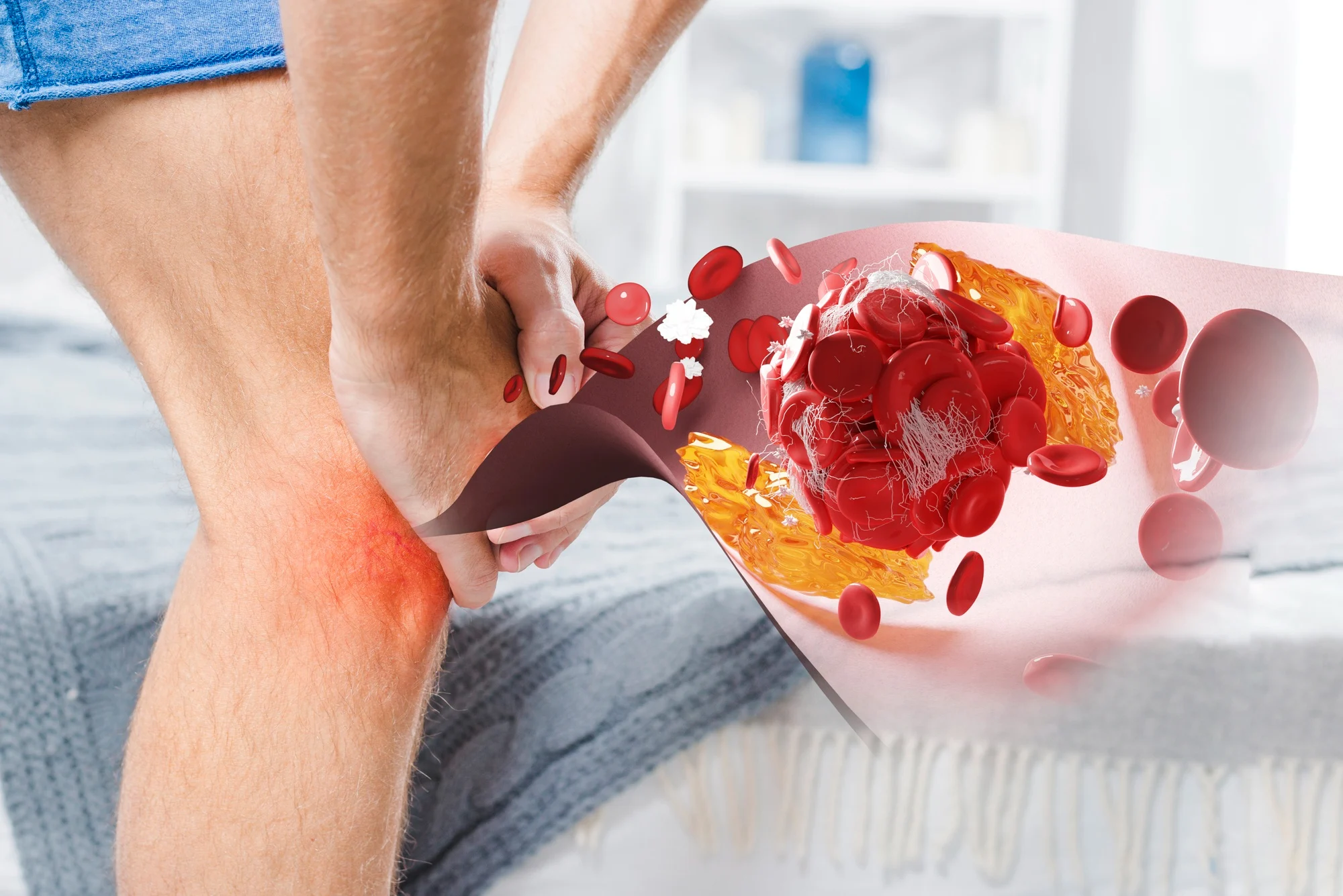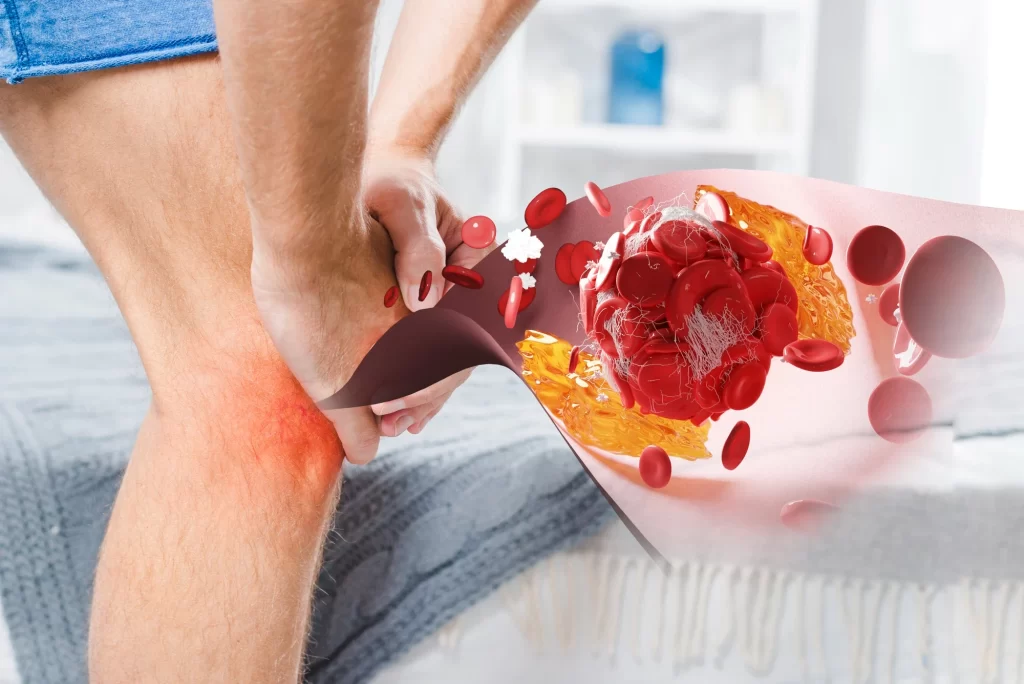
What Are Arterial Leg Ulcers and What Causes Them?
What Are Arterial Leg Ulcers and What Causes Them?
Table of Contents
ToggleQuick Summary:
- Caused by Poor Circulation– Arterial leg ulcers form when narrowed or blocked arteries reduce blood flow to the legs and feet.
- Linked to PAD and Atherosclerosis– Peripheral artery disease and hardened arteries are leading arterial ulcer causes.
- Recognizable Symptoms– Severe leg pain, pale or cool skin, slow-healing wounds, and discolored toes are common symptoms of arterial ulcers.
- High-Risk Groups– Smokers, diabetics, older adults, and those with high blood pressure or cholesterol face higher risk.
- Early Detection Is Critical – Prompt recognition and medical care can prevent infection, worsening wounds, or serious complications.
Arterial leg ulcers are painful wounds that develop when blood flow to the lower legs is restricted, preventing proper healing. This condition is serious and should never be overlooked. In this blog, we’ll explain what arterial leg ulcers are, explore the most common arterial ulcer causes, highlight key symptoms of arterial ulcers, and discuss why timely treatment is essential. If you or a loved one is dealing with persistent wounds on the legs or feet, understanding the condition is the first step toward recovery.

What Are Arterial Leg Ulcers?
An arterial leg ulcer is a type of open sore that typically forms on the lower leg, ankle, or foot. Unlike other ulcers that may heal with time and care, arterial ulcers develop when blood circulation is compromised due to narrowed or blocked arteries. Without enough oxygen-rich blood reaching the tissues, the skin and underlying layers break down, creating painful wounds that are often difficult to heal.
Without proper treatment, arterial leg ulcers may result in infections and other serious health complications. That’s why it’s so important to seek specialized care from experts who understand the complexities of wound healing. Learn more about professional treatments on our arterial leg ulcers service page.
What Causes Arterial Leg Ulcers?
The primary cause of arterial leg ulcers is poor blood circulation, usually linked to peripheral artery disease (PAD). PAD happens when fatty deposits, known as plaque, build up inside the arteries and restrict blood flow. When blood flow is restricted, the legs and feet don’t receive enough oxygen and nutrients, which can result in tissue breakdown and the development of ulcers. Here are some of the most common arterial ulcer causes explained in detail:
1. Peripheral Artery Disease (PAD)
PAD is one of the leading risk factors for arterial ulcers. As arteries narrow, it becomes harder for blood to travel efficiently to the legs and feet. People with PAD often experience cramping, numbness, or cold feet, which can make them more vulnerable to slow-healing wounds.
2. Atherosclerosis
This condition, often referred to as the “hardening of the arteries,” occurs when plaque builds up along the artery walls. Over time, the arteries lose their flexibility and become narrower, which restricts circulation. Atherosclerosis not only raises the risk of heart attack and stroke but also contributes significantly to the development of arterial ulcers.
3. Smoking
Smoking damages the arteries, lowers oxygen levels in the bloodstream, and speeds up the formation of plaque within blood vessels. Even light or occasional smoking can significantly increase the risk of arterial ulcers. Quitting smoking is one of the most effective ways to improve circulation and reduce the likelihood of ulcers forming.
4. Diabetes
Diabetes is a major contributing factor to arterial ulcers. High blood sugar damages blood vessels over time, making circulation problems worse. Combined with nerve damage (neuropathy), which can reduce the ability to feel pain, ulcers may form and worsen before they are noticed.
5. High Blood Pressure and High Cholesterol
Both conditions strain the arteries, making them weaker and more prone to damage. High cholesterol in particular contributes to plaque buildup, which narrows arteries and reduces circulation to the lower limbs.
6. Obesity and Physical Inactivity
Carrying excess weight increases pressure on the lower limbs and can worsen circulation issues. Inactivity compounds the problem, as regular movement is essential for healthy blood flow.
7. Age and Family History
Older adults are more likely to experience arterial changes and reduced circulation. In addition, those with a family history of vascular disease may have a genetic predisposition to arterial ulcers.
8. Trauma or Injury
Sometimes, even a small injury to the leg or foot can lead to an arterial ulcer if blood flow is already compromised. Because the body struggles to deliver healing resources, a minor cut or scrape may progress into a painful, non-healing wound.
By understanding these arterial ulcer causes, patients and caregivers can better recognize the risk factors and take proactive steps toward early diagnosis and treatment.
Common Symptoms of Arterial Ulcers
Recognizing the symptoms of arterial ulcers early is vital for getting timely treatment. Some of the most common signs include:
- Severe pain in the affected leg or foot – pain often worsens when legs are elevated and may improve when hanging down.
- Cool or pale skin – caused by limited circulation.
- Ulcers often appear as small, circular sores with sharply defined edges, giving them a punched-out look.
- Skin near the wound may look smooth, stretched, or lack hair growth.
- Slow-healing sores – wounds that don’t heal within weeks should be checked immediately.
- Discoloration of toes or feet – can signal reduced circulation.
If you notice these symptoms, it’s important to consult a wound care specialist as soon as possible. Early diagnosis and treatment can prevent complications.
Conclusion
Arterial leg ulcers are a serious condition caused by poor circulation and underlying health issues such as peripheral artery disease, atherosclerosis, smoking, and diabetes. Knowing the key arterial ulcer causes and recognizing the symptoms of arterial ulcers early can make all the difference in protecting your health. If you suspect you may have an arterial leg ulcer or want to explore effective treatment options. For personalized care and expert guidance, Contact us today.
Frequently Asked Questions:
1. What are arterial leg ulcers?
Arterial leg ulcers are open sores on the legs, ankles, or feet that develop due to poor circulation from narrowed or blocked arteries.
2. What causes arterial leg ulcers?
The main causes include peripheral artery disease, atherosclerosis, smoking, diabetes, high blood pressure, and high cholesterol.
3. Where do arterial ulcers usually appear?
They typically form on the lower legs, ankles, or feet, often on pressure points or bony areas.
4. What are the common symptoms of arterial ulcers?
Severe leg pain, pale or cool skin, slow-healing sores, shiny or tight skin, and discolored toes are common symptoms.
5. How can you tell arterial ulcers apart from venous ulcers?
Arterial ulcers are usually small, round, and very painful with well-defined edges, while venous ulcers are larger, less painful, and often accompanied by swelling.
6. Who is most at risk of developing arterial leg ulcers?
People with diabetes, smokers, older adults, and those with high blood pressure or high cholesterol are at higher risk.
7. Are arterial ulcers dangerous?
Yes, untreated arterial ulcers can lead to infections, gangrene, or even amputation in severe cases.
8. Can arterial leg ulcers heal on their own?
They rarely heal without medical treatment since poor circulation prevents proper wound recovery.
9. How are arterial leg ulcers diagnosed?
Doctors typically use physical exams, ankle-brachial index (ABI) tests, ultrasound, or angiography to assess circulation and diagnose ulcers.
10. What treatments are available for arterial ulcers?
Treatment may include improving circulation through lifestyle changes or procedures, proper wound care, managing underlying conditions, and pain relief.


